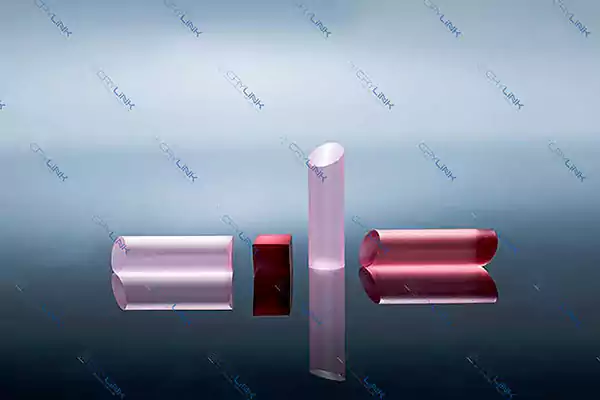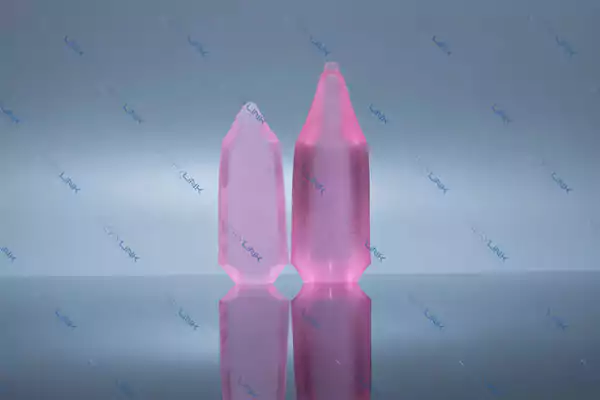In essence, laser crystals are optical crystals, more specifically, single crystals that function as the gain medium in solid-state lasers. They possess the ability to amplify light at the laser wavelength through a process known as stimulated emission. The process is initiated by supplying energy to the crystal through the absorption of pump light, a method referred to as optical pumping. Laser crystals are doped with either trivalent rare earth ions or transition metal ions, which are the key players in the light amplification process. This doping process imparts specific properties to the crystals, making them the ideal gain medium for lasers.
Laser crystals are not to be confused with laser glasses or ceramic laser gain media. They have unique properties that set them apart. These include higher transition cross-sections, smaller absorption and emission bandwidths, higher thermal conductivity, and potentially, birefringence.
In the following sections, we will explore in detail the top eight laser crystals and their unique properties.
1. Nd:YAG laser crystal
Neodymium-doped Yttrium Aluminum Garnet, or Nd:YAG, is a prominent crystal used in solid-state lasers. The lasing activity in this crystal stems from the neodymium ion, which replaces a small fraction of the yttrium ions in the host crystal structure. Nd:YAG crystals absorb mostly in bands between 730-760 nm and 790-820 nm. The amount of the neodymium dopant varies according to the desired use, with less colored rods for continuous wave output and pink-purplish rods for pulsed lasers.
- Wavelengths: Typically, Nd:YAG lasers emit light at a wavelength of 1064 nm, which lies in the infrared spectrum. However, the crystal is also capable of transitions near 946, 1120, 1320, and 1440 nm, giving it a range of potential applications.
- Applications: Nd:YAG crystals find extensive use in various fields. In medicine, they are used in ophthalmology for treatments such as correcting posterior capsular opacification, treating vitreous eye floaters, and conducting pan-retinal photocoagulation. They’re also essential for laser-induced thermotherapy and removing skin cancers. In physics, they provide the main beams for gravitational wave interferometers like LIGO and VIRGO.

2. Ti:Sapphire (Titanium Sapphire) crystal
Ti:Sapphire, also known as Titanium-doped Sapphire, is a type of laser crystal notable for its impressive range of operation. Ti:Sapphire laser is its broad bandwidth, which makes it an ideal choice for ultrafast laser systems. The tuning range of these lasers is also noteworthy, providing a level of versatility that is highly valuable in various scientific and technological settings.
- Wavelengths: From 650 nm to 1100 nm
- Applications: Produced 193 nm laser has been used in lithography machine.

3. Er: YAG (Erbium-doped YAG) crystal
Er YAG, or Erbium-doped Yttrium Aluminum Garnet, is a type of laser crystal. It is composed of yttrium, aluminum, and garnet, with erbium ions (Er3+) introduced as a dopant. The crystal structure of ErYAG is similar to that of YAG (Yttrium Aluminum Garnet), but the yttrium ions in the lattice are partially replaced by erbium ions.
Er YAG lasers are notable for their emission wavelength of 2.94 µm, which is in the mid-infrared region of the spectrum. This wavelength is strongly absorbed by water, making Er YAG lasers particularly useful in medical applications where precision is required, such as dermatology and dentistry. The strong absorption by water means that the laser energy is quickly converted to heat upon impact with tissue, leading to precise cutting and ablation with minimal thermal damage to surrounding tissues.
- Wavelength: 2940 nm
- Applications: One of the key features of the Er:YAG laser is that its output is strongly absorbed by water. This makes it an ideal choice for medical procedures where deep tissue penetration is not desired. For instance, Erbium-YAG lasers have been employed for laser resurfacing of human skin, treating conditions such as acne scarring, deep rhytides, and melasma. Moreover, the output of these lasers is also absorbed by hydroxyapatite, making them well-suited for cutting bone as well as soft tissue.
In the dental field, Erbium YAG lasers have shown their effectiveness in removing tooth decay atraumatically. They can often perform this function without the need for local anesthesia to numb the tooth. By eliminating the vibration of the dental drill, these lasers reduce the risk of causing microfractures in the tooth. Furthermore, when used initially at low power settings, the laser energy has a sedative effect on the nerve, enabling the power to be subsequently increased without creating a sensation of pain in the tooth.

4. Nd:YVO4 laser crystal
Nd:YVO4 (Neodymium-doped Yttrium Orthovanadate) is a popular crystal used in diode-pumped solid-state lasers (DPSSL). This crystal is particularly advantageous due to its large stimulated emission cross-section, high absorption coefficient, and broad absorption bandwidth.
- Wavelengths: Emit at 1064 nm and 1342 nm.
- Applications: In precision manufacturing, including microelectronics and solar cell production. They are also used in the field of medical technology, where they offer a diverse range of capabilities, including precision cutting and ablation.

5. Yb:YAG (Ytterbium doped YAG) laser crystal
Yb: YAG, or Ytterbium-doped Yttrium Aluminium Garnet, is a laser crystal used for various purposes. It’s a preferred choice for many applications due to its efficiency and properties. This crystal was developed in the late 1990s and is known for its emission at 1.03 μm. Its most noteworthy feature is its ability to handle high power, with a thermal loading capacity as high as 250 kW/cm². Additionally, Yb:YAG is more efficient than other popular laser materials such as Nd:YAG due to the four-level system of the Yb ion.
- Wavelengths:1030 nm
- Applications: Yb:YAG lasers are widely used in industrial settings for cutting and drilling. Their high power and efficiency make them ideal for these tasks. In the medical field, they are used in dermatology and dentistry, providing versatile utility across different sectors.

6. Tm:YLF laser crystal
Thulium doped yttrium fluoride lithium (Tm: YLF) crystals have a low nonlinear refractive index and thermo optic constant, which are very suitable for the application in the fields of scientific research, production, education, and other optoelectronic fields. Tm: YLF crystal is a negative uniaxial crystal with a negative refractive index temperature coefficient, which can offset some thermal distortion and thus has high beam quality output.
The pump wavelength is 792 nm, and the linear polarized laser with the wavelength of 1900nm outputs in the direction of an axis. outputting light from the c axis is non-linear polarized. High power laser output can be obtained by selecting the proper crystal size and doping concentration. Two-micron Tm3+ lasers are of interest for many applications in the scientific, defense, and medical fields. Thulium readily substitutes many crystal hosts that are suitable for high-average-power laser systems and it has an absorption band at ~0.8 μm allowing excitation with commercially available high power laser diodes.
- Wavelength: The pump wavelength is 792 nm
- Applications: For the application in the fields of scientific research, production, education, and other optoelectronic fields.

7. Yb:CaF2 (Ytterbium-doped Calcium Fluoride) crystal
Yb:CaF2 crystals are doped with ytterbium ions, which provide broad absorption and emission bands in the near-infrared range. These crystals exhibit high thermal conductivity and excellent optical quality, allowing for efficient heat dissipation and minimal thermal effects. Yb:CaF2 crystals have a long fluorescence lifetime and high quantum efficiency, making them suitable for high-power laser applications.
- Wavelength: Typically around 1 micrometer.
- Applications: Yb:CaF2 crystals find applications in fields such as industrial materials processing, scientific research, and medical treatments. Their broad absorption bands allow for efficient pumping using diode lasers, resulting in high-power laser output. Yb:CaF2 lasers are used for cutting, welding, and engraving metals, as well as for pumping other laser systems. They are also employed in scientific research for spectroscopy, ultrafast pulse generation, and nonlinear optics. In medical applications, Yb:CaF2 lasers can be used for surgical procedures and photodynamic therapy.

8. Ho:YAG (Holmium-doped Yttrium Aluminum Garnet) crystal
Ho:YAG crystals are doped with holmium ions, which provide efficient laser transitions in the mid-infrared region. These crystals have broad absorption and emission bands in the near-infrared and mid-infrared range. Ho:YAG crystals exhibit high thermal conductivity and excellent optical properties, making them suitable for high-power laser applications. They also possess a long upper-state lifetime, enabling efficient energy storage and high energy extraction.
- Wavelength: Around 2.1 micrometers
- Applications: Ho:YAG crystals find applications in fields such as medical treatments, scientific research, and military applications. Their emission wavelength at around 2.1 micrometers is highly absorbed by water, making them effective for surgical procedures such as lithotripsy (breaking kidney stones) and tissue ablation. Ho:YAG lasers are also used for scientific research, including spectroscopy, laser-induced breakdown spectroscopy, and remote sensing. In military applications, Ho:YAG lasers are utilized for target designation, range finding, and active imaging.


Frank
Frank graduated from the University of Shanghai for Science and Technology, majoring in optics. As a technical engineer at Crylink Company, he deeply understands crystal materials and laser components.
Related Video(s) with this Article
Related Product(s) with this Article
Related Application(s) with this Article








